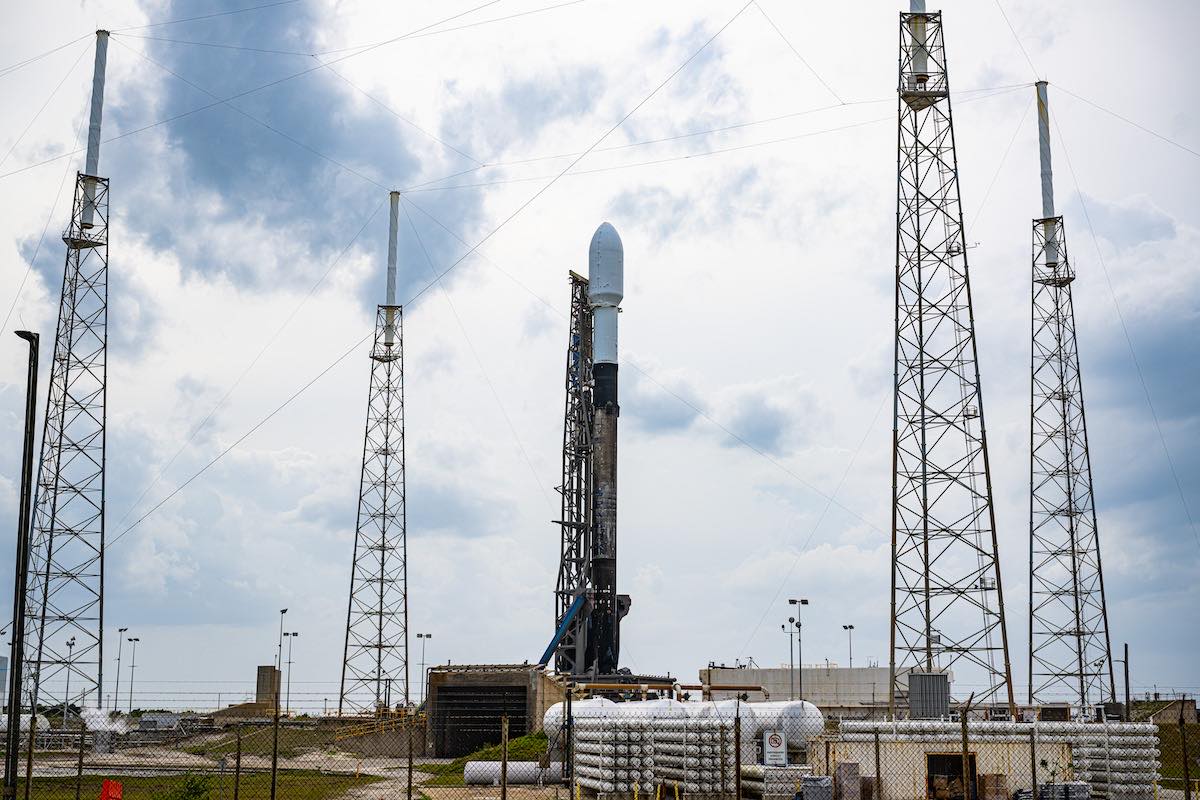Live coverage of the countdown and launch of a SpaceX Falcon 9 rocket from pad 40 at Cape Canaveral Space Force Station, Florida. The Transporter 4 mission will launch 40 small payloads from customers around the world. Follow us on Twitter.
SFN Live
SpaceX Mission Audio
SpaceX launched a Falcon 9 rocket from pad 40 at Cape Canaveral Space Force Station at 12:24 p.m. EDT (1624 GMT) Friday with with 40 satellites to begin Earth-observing, communications, and technology demonstration missions.
There was a 60% chance that weather conditions will be favorable for launch Friday, according to the U.S. Space Force’s 45th Weather Squadron. A stalled cold front is predicted to be over Central Florida at the time of Friday’s instantaneous launch opportunity, but forecasters Friday morning upped their odds of good weather from 30% to 60% as thunderstorms moved south of the spaceport.
The Falcon 9 rocket headed southeast from Cape Canaveral, then south along Florida’s east coast to place the mission’s 40 payloads into polar orbit.
The rocket’s first stage landed on the drone ship “Just Read the Instructions” parked in the Atlantic Ocean between Cuba and the Bahamas, about 330 miles (530 kilometers) downrange from Cape Canaveral. The booster achieved its seventh flight to space since its first mission with NASA’s Crew-1 astronauts in November 2020.
The second stage released the mission’s largest payload, Germany’s EnMAP environmental monitoring spacecraft, at an altitude of about 404 miles (650 kilometers). Two smaller payloads also deployed at that altitude. That milestone was followed by two more second stage burns to lower the rocket’s orbit to roughly 310 miles (500 kilometers) for separation of the remaining satellites.
The 2,160-pound (980-kilogram) EnMAP spacecraft carries a hyperspectral Earth imaging instrument to survey crops, forests, and other surfaces, providing detailed information about the state of vegetation and plant health.

The Transporter 4 mission was SpaceX’s fourth dedicated small satellite rideshare launches since January 2021, and the second of four Transporter rideshare flights planned this year.
SpaceX launched the first Transporter mission on Jan. 24, 2021, with a record 143 satellites on a single rocket. The Transporter 2 mission on June 30, 2021, carried 88 payloads into orbit, and Transporter 3 launched Jan. 13 with 105 spacecraft.
The manifest for Transporter 4 was down to 40 spacecraft, but that was primarily due to EnMAP’s presence on the mission. The satellite is heavier than any of the satellites SpaceX has flown on any of the previous Transporter missions, and the Falcon 9 delivered EnMAP to an orbit higher than the the past rideshare launches.
Those factors prevented the Falcon 9 booster from returning to landing at Cape Canaveral, as it did on the past two Transporter rideshare flights. On Transporter 4, the first stage provided a boost lasting 15 more seconds than on the Transporter 3 mission in January, leaving insufficient propellant to fly back to Florida’s Space Coast. Instead, the booster headed for SpaceX’s rocket landing platform.
Read our mission preview story for details on the Transporter 4 launch.
ROCKET: Falcon 9 (B1061.7)
PAYLOAD: 40 microsatellites, CubeSats, picosatellites, an orbital transfer vehicles, and hosted payloads
LAUNCH SITE: SLC-40, Cape Canaveral Space Force Station, Florida
LAUNCH DATE: April 1, 2022
LAUNCH TIME: 12:24:17 p.m. EDT (1624:17 GMT)
LAUNCH WINDOW: Instantaneous
WEATHER FORECAST: 60% probability of acceptable weather
BOOSTER RECOVERY: “Just Read the Instructions” drone ship
LAUNCH AZIMUTH: South-southeast, then south
TARGET ORBIT: Approximately 404 miles (640 kilometers), 97.9 degrees inclination for the first three payloads; Approximately 310 miles (500 kilometers), 97.4 degrees inclination for the remaining payloads
LAUNCH TIMELINE:
- T+00:00: Liftoff
- T+01:12: Maximum aerodynamic pressure (Max-Q)
- T+02:30: First stage main engine cutoff (MECO)
- T+02:34: Stage separation
- T+02:41: Second stage engine ignition
- T+03:01: Fairing jettison
- T+08:40: First stage entry burn ignition (three engines)
- T+09:09: First stage entry burn ends
- T+09:59: Second stage engine cutoff (SECO 1)
- T+09:59: First stage landing burn ignition (one engine)
- T+10:26: First stage landing
- T+14:00: EnMAP separation
- T+16:41: LEO-1 separation
- T+17:30: GNOMES 3 separation
- T+28:43: Second stage engine restart
- T+28:45: Second stage engine cutoff (SECO 2)
- T+1:08:28: Second stage engine restart
- T+1:08:29: Second stage engine cutoff (SECO 3)
- T+1:14:42: ARCSAT separation
- T+1:14:54: AlfaCrux separation
- T+1:15:07: 12 Swarms satellite separation
- T+1:16:22: Shakuntala separation
- T+1:16:39: BDSAT separation
- T+1:17:08: BRO 7 separation
- T+1:17:28: NewSat 27 separation
- T+1:17:44: NewSat 23 separation
- T+1:18:43: NewSat 24 separation
- T+1:20:18: NewSat 25 separation
- T+1:22:48: NewSat 26 separation
- T+1:23:25: Hawk 4C separation
- T+1:23:36: Hawk 4B separation
- T+1:24:13: Hawk 4A separation
- T+1:25:46: MP42 separation
- T+1:25:58: Lynk Tower 1 separation
- T+1:26:17: ION SCV 005 transfer vehicle separation
MISSION STATS:
- 146th launch of a Falcon 9 rocket since 2010
- 154th launch of Falcon rocket family since 2006
- 7th launch of Falcon 9 booster B1061
- 128th Falcon 9 launch from Florida’s Space Coast
- 83rd Falcon 9 launch from pad 40
- 138th launch overall from pad 40
- 89th flight of a reused Falcon 9 booster
- 4th Transporter rideshare mission launched by SpaceX
- 12th Falcon 9 launch of 2022
- 12th launch by SpaceX in 2022
- 13th orbital launch based out of Cape Canaveral in 2022
Email the author.
Follow Stephen Clark on Twitter: @StephenClark1.
